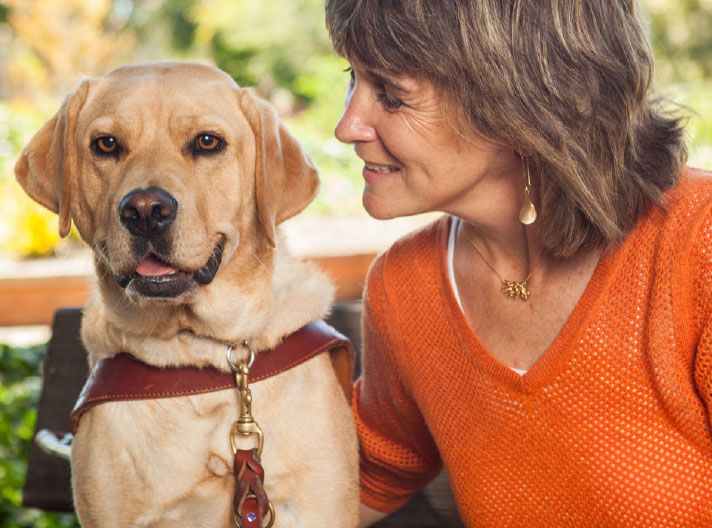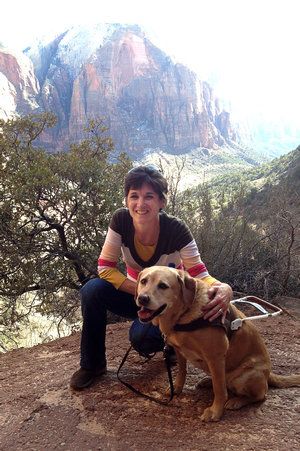My guide dog and me: A renewed sense of independence with retinitis pigmentosa
April 5, 2017
Becky Andrews, diagnosed with retinitis pigmentosa at 18, found a new freedom in life when she decided to partner with a guide dog.

Becky Andrews and her third guide dog, Georgie. Becky’s dogs have helped the Utah mom raise two kids, start a business with her husband, and train for marathons. Photo courtesy of Guide Dogs for the Blind.
Becky Andrews slipped out of the room and left the hospital wing where her father lay recovering from surgery. She was in search of an exit to the outside, and the sheer size of the University of Utah hospital made it a daunting task. Winding her way through the labyrinth of corridors, she almost felt as if she should leave a trail of bread crumbs to find her way back. Thanks to Georgie, however, that wouldn’t be necessary.
Georgie is Becky’s guide dog, and before the two had started the traverse to the exit, Becky had patted the wall outside her father’s hospital room and said “room” a few times to the dog. It gave Georgie a point of reference. Then, following directions from the floor nurse, Becky and Georgie turned this way and that, hopped one elevator and then another, to finally make their way outside.
Suddenly I had this sweet partner who was going to keep me safe, and we were going to go where we wanted to go. It shifted my whole perspective and opened the world back up for me.”
On their return, Becky, whose blindness is the result of retinitis pigmentosa (RP), an inherited retinal disease (IRD), said “Georgie, find ‘room!’” With a wag of her tail, the yellow lab started off, leading her favorite human back the way they had originally come. When they rounded the final corner on her father’s floor, Becky’s mom and brother stood waiting, concerned that Becky may have gotten lost. Smiling, she patted Georgie and said to her family, “It’s okay. We’ve got this.”
Choosing the guide dog lifestyle
Twenty years earlier, Becky, who is now 52, could not have imagined herself confidently traveling the hallways and corridors of a sprawling, unfamiliar hospital. In fact, during that period of her life, she was having an increasingly challenging time simply navigating the well-known haunts of Bountiful, Utah, her hometown.
Like so many people with retinitis pigmentosa, each advancement of her disease—and the associated vision loss that accompanied it—caused incremental changes in the way Becky walked through her world. She became progressively measured, careful and cautious. She found herself relying more and more on her husband and her two children—who were then 10 and 12—to help her pilot daily life. The change did not sit well with the 32-year-old. Life was busy and she wanted to keep pace. Even more than that, she wanted to thrive.
Then, Becky had her “aha” moment. While talking with a friend who owned a guide dog, the friend described what a difference the dog had made in her life, and how much simpler travel had become now that she had a four-footed guide. That’s when Becky realized that with a guide dog, she might find it easier to keep up with her kids’ activities, her professional obligations, and her own globe-trotting ways.
Transitioning from walking through life solo to traveling hand-on-harness, connected to a four-legged companion, is not a small one. There are plenty of questions people consider, prior to making the decision:
- Do I have to be totally blind to get a guide dog?
- How much does a guide dog cost?
- Who will teach me how to work with my dog?
- Won’t walking down the street with a guide dog scream, “I’m blind!”
- Do I even LIKE dogs?
Becky asked herself these questions and many more, prior to making the decision to get a guide dog. She soon found out that those with low vision, as well as those who are completely blind, are candidates for a dog—if they are willing and able to use their dogs daily. While guide dogs are trained extensively and arrive ready to guide, it’s “use it or lose it” for these working canines.
For those who qualify, guide dogs are free of charge, despite the estimated $40,000 worth of resources that go into transforming a puppy into a guide-ready companion. In fact, an army of volunteers raise, train, feed and care for the dogs to prepare them for their career.
Certainly, walking with a guide dog gives other people a visual cue that the owner has vision loss, but so does using a white cane, or as Becky has done in the past, running into walls!
At 32, Becky finally made the decision to welcome a guide dog into her life. She filled out the application paperwork from Guide Dogs for the Blind (GDB). She sent in her letters of recommendation. She had her physical, so that GDB knew she was fit enough to attend the one-month training program, where she would learn how to work with her new dog. She nervously welcomed into her home the representative from GDB, and sat through the home interview.
After she had completed every step in the application process, she waited. Would she be approved? Was the fact that their family dog stole a waffle off the table and sauntered through the living room during the interview going to be a deal breaker? When the letter arrived inviting her to guide dog school for training, and to pick up the newest member of her family, Becky was ecstatic. She was going to get a dog!
The gifts of a guide dog
When Becky finally brought home Pantera, her first guide dog, the visually impaired mom from Utah regained a confidence she hadn’t even realized she’d lost. “I remember walking and not having to count my steps or be so cautious, and I thought, ‘If I can do this, what else can I do in my life?!” says Becky. “Suddenly I had this sweet partner who was going to keep me safe, and we were going to go where we wanted to go. It shifted my whole perspective and opened the world back up for me.”
Guide dogs have walked by Becky’s side as she raised her son and daughter, started a business with her husband, and trained to run marathons. Pantera made way for Cricket, and Cricket for Georgie. Those hard-working and loving dogs have guided Becky through airports, cities, offices and, yes, large metropolitan hospitals. Becky knows that without her canine partners, life would be a different experience. “My guide dogs allow me to just be a part of things,” she says. “Whether it’s a conference, a meeting, travel, or whatever. My dog is keeping track of all the little details, so that I can just enjoy life.”

Becky and her second guide dog, Cricket, hiking Angels Landing at Zion National Park, in Utah.
For more information about Guide Dogs for the Blind, please visit guidedogs.com.
Sign up to find out when we add new stories to the site.
